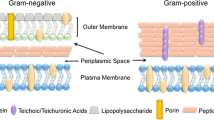Abstract
The aim of this work was to investigate the antibacterial and antiviral properties of a riboflavin derivative (Vitamin B2), flavin mononucleotide and its derivative, synthesized by conjugation with polyethylene glycol (Rf–PEG). Flavin mononucleotide and conjugate of riboflavin with polyethylene glycol were investigated. Staphylococcus aureus, Pseudomonas aeruginosa, Escherichia coli, and Salmonella typhimurium were used as clinical isolates. Due to the growing number of antibiotic-resistant microorganisms, it is necessary to search for new strategies aimed at inactivating pathogens and preventing them from becoming drug-resistant. Antimicrobial photodynamic therapy (aPDT) is a promising approach to inactivate pathogens regardless of their antibiotic resistance status. The work investigated the antibacterial and antiviral properties of the derivative of riboflavin (Vitamin B2), flavin mononucleotide and its derivative synthesized by conjugation with polyethylene glycol (Rf–PEG). It has been shown that hydrophilic riboflavin derivatives are effective photosensitizers and provide inactivation of both gram-positive and -negative microorganisms during aPDT in vitro.


Similar content being viewed by others
REFERENCES
D’Costa, V.M., King, C.E., Kalan, L., Morar, M., Sung, W.W., Schwarz, C., et al., Antibiotic resistance is ancient, Nature, 2011, vol. 477, no. 7365, pp. 457–461. https://doi.org/10.1038/nature10388
Krammer, B. and Verwanger, T., in Photodynamic Medicine: From Bench to Clinic, Royal Society of Chemistry, 2016, vol. 2, pp. 63–74. https://doi.org/10.1039/9781782626824-00063.
Sperandio, F.F., Huang, Y.Y., and Hamblin, M.R., Antimicrobial photodynamic therapy to kill Gram-negative bacteria, Recent Pat. Anti-Infect. Drug Discovery, 2013, vol. 8, no. 2, pp. 108–120. https://doi.org/10.2174/1574891x113089990012
Wainwright, M. and Crossley, K.B., Methylene Blue - a therapeutic dye for all seasons?, J. Chemother., 2002, vol. 14, pp. 431–443. https://doi.org/10.1179/joc.2002.14.5.431
Amescua, G., Arboleda, A., Nikpoor, N., Durkee, H., Relhan, N., Aguilar, M.C., et al., Rose Bengal photodynamic antimicrobial therapy: A novel treatment for resistant Fusarium keratitis, Cornea, 2017, vol. 36, pp. 1141–1144. https://doi.org/10.1097/ICO.0000000000001265
Chiniforush, N., Pourhajibagher, M., Parker, S., Shahabi, S., and Bahador, A., The in vitro effect of antimicrobial photodynamic therapy with indocyanine green on Enterococcus faecalis: Influence of a washing vs non-washing procedure, Photodiagn. Photodyn. Ther., 2016, vol. 16, pp. 119–123. https://doi.org/10.1016/j.pdpdt.2016.09.007
Maisch, T., Bosl, C., Szeimies, R.M., Lehn, N., and Abels, C., Photodynamic effects of novel XF porphyrin derivatives on prokaryotic and eukaryotic cells, Antimicrob. Agents Chemother., 2005, vol. 49, pp. 1542–1552. https://doi.org/10.1128/AAC.49.4.1542-1552.2005
Vecchio, D., Dai, T., Huang, L., Fantetti, L., Roncucci, G., and Hamblin, M.R., Antimicrobial photodynamic therapy with RLP068 kills methicillin-resistant Staphylococcus aureus and improves wound healing in a mouse model of infected skin abrasion PDT with RLP068/Cl in infected mouse skin abrasion, J. Biophotonics, 2013, vol. 6, no. 9, pp. 77–81. https://doi.org/10.1002/jbio.201200121
Huang, L., Krayer, M., Roubil, J.G., Huang, Y.Y., Holten, D., Lindsey, J.S., et al., Stable synthetic mono-substituted cationic bacteriochlorins mediate selective broad-spectrum photoinactivation of drug-resistant pathogens at nanomolar concentrations, J. Photochem. Photobiol., B, 2014, vol. 141, pp. 119–127. https://doi.org/10.1016/j.jphotobiol.2014.09.016
Entsch, B. and Ballou, D.P., Flavins, in Encyclopedia of Biological Chemistry, Amsterdam: Elsevier, 2013, pp. 309–313.
Akasov, R.A., Sholina, N.V., Khochenkov, D.A., Alova, A.V., Gorelkin, P.V., Erofeev, A.S., et al., Photodynamic therapy of melanoma by blue-light photoactivation of flavin mononucleotide, Sci. Rep., 2019, vol. 9, p. 9679. https://doi.org/10.1038/s41598-019-46115-w
Khaydukov, E.V., Mironova, K.E., Semchishen, V.A., Generalova, A.N., Nechaev, A.V., Khochenkov, D.A., et al., Riboflavin photoactivation by upconversion nanoparticles for cancer treatment, Sci. Rep., 2016, vol. 6, p. 35103. https://doi.org/10.1038/srep35103
Goodrich, R.P. and Platz, M.S., The design and development of selective, photoactivated drugs for sterilization of blood products, Drugs Future, 1997, vol. 2, pp. 159–171. https://doi.org/10.1358/DOF.1997.022.02.400935
Davies, C.E., Wilson, M.J., Hill, K.E., Stephens, P., Hill, C.M., Harding, K.G., et al., Use of molecular techniques to study microbial diversity in the skin: Chronic wounds reevaluated, Wound Repair Regener., 2001, vol. 9, pp. 332–340. https://doi.org/10.1046/j.1524-475x.2001.00332.x
Funding
The work was funded by the Ministry of Science and Higher Education as part of the work in the framework of a state assignment to the Federal Research Center “Crystallography and Photonics” of the Russian Academy of Sciences (studying the photosensitizing properties of the riboflavin conjugate) and Russian Foundation for Basic Research grant no. 20-04-60357 (studying the antimicrobial and antiviral activity of riboflavin derivatives).
Author information
Authors and Affiliations
Corresponding author
Ethics declarations
The authors declare that they have no conflict of interest. This article does not contain any studies involving animals or human beings performed by any of the authors.
Additional information
Translated by A. Bulaev
About this article
Cite this article
Borodina, T.N., Tolordava, E.R., Nikolaeva, M.E. et al. Antimicrobial Photodynamic Activity of Hydrophilic Riboflavin Derivatives. Mol. Genet. Microbiol. Virol. 36, 176–180 (2021). https://doi.org/10.3103/S0891416821040042
Received:
Revised:
Accepted:
Published:
Issue Date:
DOI: https://doi.org/10.3103/S0891416821040042




